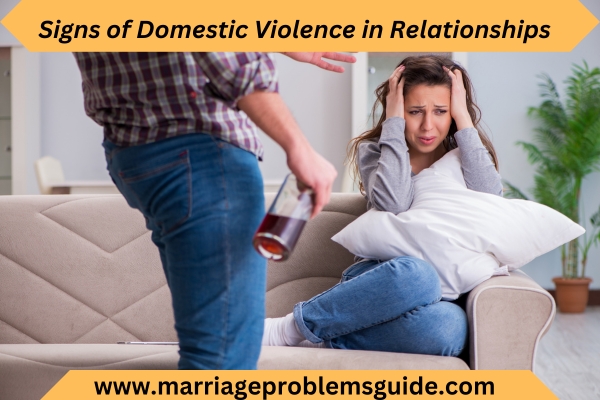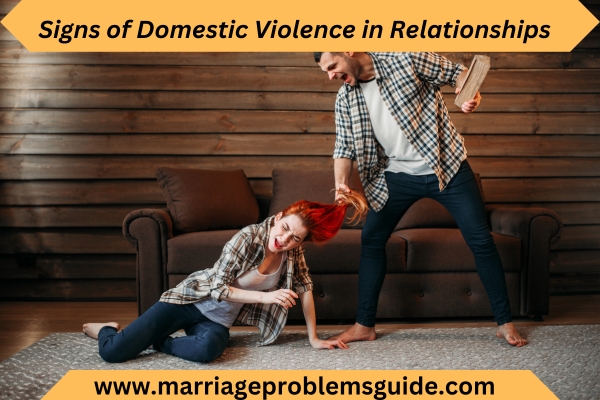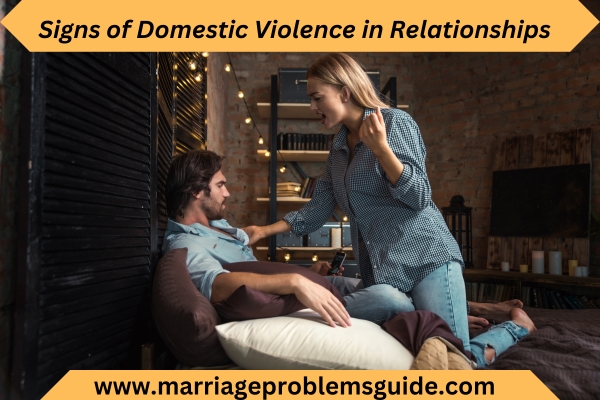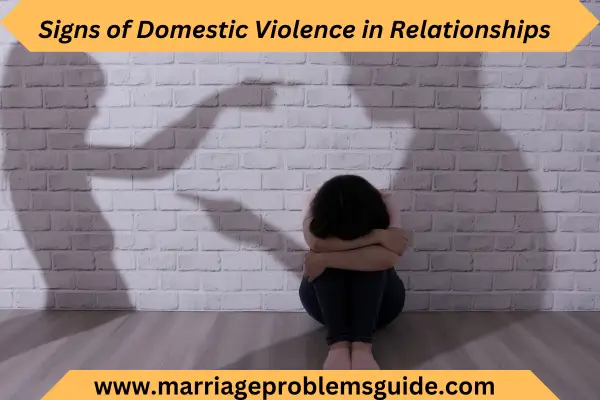Signs of Domestic Violence in Relationships
Domestic violence is a serious issue that affects millions of people worldwide. According to the National Coalition Against Domestic Violence, nearly 20 people per minute are physically abused by an intimate partner in the United States.
Domestic violence can take many forms, including physical, sexual, emotional, economic, and psychological abuse. While physical abuse may be the most obvious sign, domestic violence often begins subtly with verbal putdowns, isolation from friends and family, or controlling behavior.
It’s important to recognize the early warning signs of an abusive relationship. In this blog article, we are sharing types of domestic violence and some of the most common red flags and signs that lead to abusive relationships.
Types of Domestic Violence
Domestic violence can take many forms beyond physical abuse. Being able to recognize the different types of domestic violence is important for victims to understand what is happening and get help.
Physical Abuse
Physical abuse involves using physical force against a partner in a way that injures or endangers them. Examples include hitting, punching, slapping, choking, burning, pushing, and other types of contact intended to harm or intimidate. Physical abuse also includes restraining a partner against their will.
Sexual Abuse
Sexual abuse is non-consensual sexual contact of any kind within an intimate relationship. It may involve actual sex acts or unwanted touching, kissing, or groping. Sexual abuse includes marital rape and pressuring a partner into uncomfortable or humiliating sexual acts.
Emotional Abuse
Emotional abuse involves non-physical behaviors such as threats, insults, constant monitoring, humiliation, intimidation, isolation, and stalking. The cumulative effect over time severely damages self-esteem and self-worth.
Economic Abuse
Economic abuse entails controlling a victim’s ability to acquire, use, manage, maintain, or dispose of economic resources like money, credit, assets, or financial transactions. For example, restricting access to bank accounts, maxing out credit cards, controlling all finances, and preventing attendance at school or employment.
Psychological Abuse
Psychological abuse involves trauma to the victim caused by acts, threats of acts, or coercive tactics. It can include blaming, shaming, stalking, undermining self-worth, harassing, denying basic needs are met, and more. These acts control, frighten, intimidate, humiliate, coerce, punish, or otherwise harm the victim.
Being able to recognize the signs of these types of domestic violence is critical. All forms are unacceptable and have significant short and long-term impacts on the victim’s physical, mental, and emotional health.

Signs of Abusive Relationship
1. Controlling Behavior
One of the first and most common signs of domestic violence is when a partner exerts controlling behavior over the relationship. This controlling behavior can manifest in several ways:
- Telling you who you can and cannot see or talk to. An abusive partner may forbid you from seeing certain friends or family members. They may monitor your calls and texts to control who you communicate with.
- Monitoring your phone calls, text messages, or social media interactions. Abusers may demand access to your devices and accounts to monitor all communications. They may read your texts, listen to voicemails, or stalk your activity on social media.
- Demanding to know where you are at all times. Abusers expect constant check-ins and updates on your location. They may call or text frequently to verify your whereabouts.
- Restricting access to money or transportation. By limiting access to financial resources or vehicles, the abuser gains power by reducing independence. This makes it harder to leave the relationship.
These controlling tactics allow abusers to isolate their partners. The goal is to increase dependence on the abuser while removing external influences that could empower the victim.
2. Possessiveness
Extreme jealousy and false accusations are common signs of domestic abuse. Abusers may continuously question you about previous or current relationships.
They may call frequently when you are out with friends. An abusive partner may monitor your social media accounts, looking for signs you are cheating.
This extreme possessiveness stems from profound insecurity. Abusers view their partner as an object they must control, not an equal partner in a healthy relationship. Their jealousy is rooted in a fear of losing control over you.
3. Manipulation
Abusers are masters of manipulation, using lies, false promises, threats, and guilt to control their victims. For example, an abusive partner may threaten to harm themselves if you leave the relationship. They may promise to change their behavior, only to later deny the abuse occurred.
This manipulation keeps the victim walking on eggshells, disrupting their sense of reality. It creates confusion and self-doubt, enhancing the abuser’s control.

4. Put Downs
Domestic abuse often involves steady humiliation through criticism, name-calling, and public embarrassment. Abusers undermine their victim’s self-esteem to make them feel unworthy of love and belonging.
Over time, this psychological abuse can severely damage self-confidence. The victim begins to believe the put-downs, making them less likely to stand up to the abuse.
5. Isolation
Abusers purposefully isolate their partner from family and friends who could provide support. This removes the victim’s support system, increasing dependence on the abusive partner.
An isolating partner may pick fights before social events to keep you from attending. They may refuse to participate in a couple activities with other people. This isolation damages social connections, leaving the victim feeling alone.
6. Intimidation
Intimidation induces fear through implied threats. For example, an abuser may punch walls, slam doors or break objects during arguments. They may threaten violence by talking about wanting to hurt someone. Abusers may also harm pets to terrorize their victims.
Living in constant fear of violence is emotionally exhausting. Intimidation keeps the victim in a heightened state of anxiety and less likely to stand up to future abuse.
7. Blaming
Abusers rarely take responsibility for their abusive behavior. They externalize blame onto the victim, downplaying their own role. For example, they may say “You provoked me,” or “It wasn’t that bad.”
This blaming creates confusion for the victim, distorting their sense of reality. It prevents addressing the root cause of abuse and allows the cycle to continue.
8. Mood Swings
Dramatic mood swings are common in abusive relationships. The abuser may shift from aggressive to apologetic and back again. They may act extremely loving after abusive incidents, denying or minimizing their behavior.
These Jekyll-and-Hyde mood shifts add to the victim’s confusion and self-doubt. It provides false hope that the abuse is over, further trapping victims.

What To Do If You Are Experiencing Domestic Violence
If you see signs of domestic violence in your relationship, it is important to have a safety plan in place. Consider taking some or all of these actions:
- Call a domestic violence hotline to speak with an advocate anonymously and confidentially. They can provide emotional support, counseling, and resources, and assist with safety planning.
- Call 911 if you are in immediate danger. Flee the situation if possible and get to a safe location. Inform responders if the abuser has access to weapons.
- Identify safe places you can go if you need to quickly leave home, such as a domestic violence shelter, the home of a trusted friend or family member, a women’s shelter, or public places (library, community center, places of worship).
- Have a packed bag ready with essential documents, medications, cash, and spare clothes in case you need to leave quickly. Store it at a trusted friend or relative’s home.
- Create a code word you can text or say to signal to friends or family to call for help.
- Document all incidents of abuse – take photos of injuries, keep a journal, and save threatening texts or emails. This creates a record that may help obtain a restraining order.
- Consult with a divorce attorney and know your legal rights regarding separation, child custody, and obtaining restraining orders.
Getting support and having an exit strategy in place is essential to being able to leave an abusive relationship safely. You deserve to feel safe, heard, and helped.

Resources For Victims Of Domestic Violence
If you are experiencing domestic violence, help is available:
National Domestic Violence Hotline – Highly trained advocates provide confidential crisis intervention 24/7. Call 1-800-799-SAFE (7233) or text LOVEIS to 22522.
Online Chat – Chat anonymously with an advocate through thehotline.org between 7am-2am CST.
Local Domestic Violence Shelters – Emergency shelter, counseling, legal help, support groups. Find one at DomesticShelters.org.
Domestic Abuse Helpline for Men – Helpline for male victims available 24/7 at 1-888-7HELPLINE (1-888-743-5754)
Child & Family Services Agency – Assists victims of domestic violence and their children. Locate a nearby office at childwelfare.gov.
Legal Aid Office – Low-income victims can get free legal help with restraining orders, child custody, and immigration needs. Find local aid at LawHelp.org.
Counseling Services – Work with a licensed therapist who specializes in domestic abuse issues. Contact your health insurance provider for referrals.
Support Groups – Gain strength and support by sharing experiences and learning from others. Find local groups at DomesticShelters.org.
Domestic violence affects millions of people across all demographics. While physical abuse may be the most visible sign, many other subtle forms of control and coercion exist in abusive relationships.
Recognizing the early warning signs is critical to be able to safely exit abusive situations before the behavior escalates.
If you see any red flags in your own relationship, know that help and support are available. Reach out to domestic violence hotlines, shelters, legal aid offices, counselors, and support groups. You have rights and options.
The most important thing is your safety – don’t hesitate to ask for help. With the right support, you can regain your self-worth, empower yourself, and live free of abuse. Learn here more about domestic violence tips and guidance.


